Disclaimer: these 'simulations' are in no way scientific... they are heavily biased... very subjective... and can't actually represent any specific river conditions. But, rivers are incredibly complex and even the best of models often fail to predict river activity. This at least offers a visual demonstration of some of the concerns around dredging and channelizing rivers.
The setup:

The following videos simulate a flood passing through the above channelized river with a bend in it. A 'flood wall' (in this case made of clay) protects the village of 'West Centerbury'. The city has channelized the river to 'speed up the flow' in an effort to reduce flood risk. But, in this case, the channelization directs the flow right into the flood wall, increasing erosion. Each 'flood' is about 3 small tin buckets worth of water. Sorry for the shakiness of the video!
(see below)
Flood 1:
The raging waters eat away at the flood wall, especially on its downstream end. Thankfully, the walls hold... for now.
Flood 2:
The second rush of water quickly erodes the damaged flood wall. The river shifts course through 'town', raging down the little main street. The little pebbles that represent houses roll over and are submerged. Actual houses would not fare so well. Note, in particular, that the whole river shifts outside the channel. Once a river jumps out of an unnatural channel, it often has no way to get back in, especially if there are also levees.
I went back to the river and did a 'restoration project': I widened the river bank and put some pebbles ('boulders') and leaves and roots ('riparian vegetation') in the channel. Then I put the same amount of water down the 'river' again. The 'restoration project' was pretty sorry, since tossing stuff in the riverbed is a lot less effective than protecting trees with deep roots, but, it still made a difference in this case. I also put more effort into shoring up the flood wall itself... rather than trying to alter the river. The point is that it is very important to protect, maintain, and reinforce structures that protect us from floods, but isn't a good idea to try to engineer the whole river. Adding to my point, I didn't really shore up the little bridge, and after these three 'floods' it washed away.
Then I unleashed a second flood:
While there was erosion along the banks, the water was moving slower, and did not rampage through the town like the first series of floods did. One 'home' had a close call, but it was not destroyed.
I also tried a larger-scale channelization experiment:
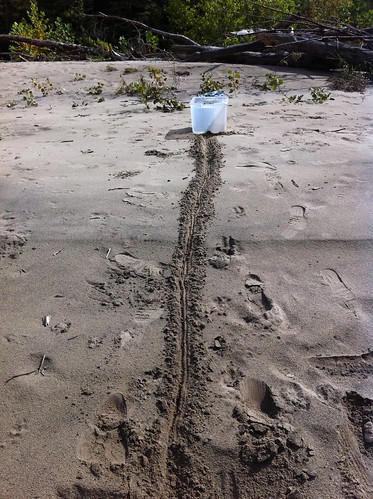
This is just a straight channel, flowing downhill, with some changes in steepness along the way. I wanted to see how long the river stayed within the channel.
Things went well at first:
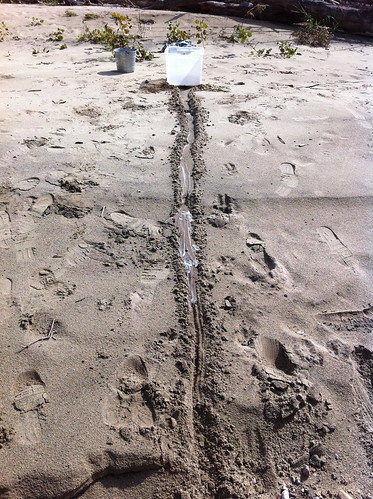
Still, notice the area below the little ledge, where the water slows down a bit. There is a lot of deposition here...
After a bit more water:
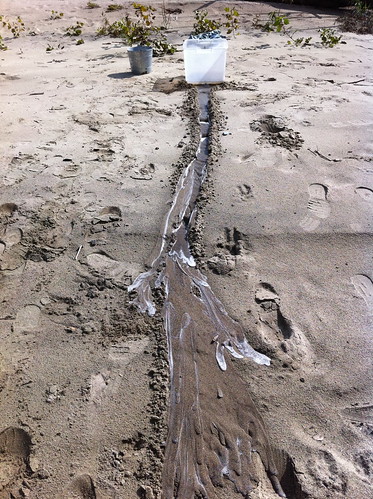
The upper part of the channel works great, though the walls are getting a bit eroded. Downstream, it's a whole different story. At the point where the water slows down a bit, it dumps sediment in the channel. No matter how deep it is, there isn't much space here to store sediment, so it quickly fills. Once it is fully, the water fans out, creating an alluvial fan. Presumably this fan would be dumping muck and sediment in homes and farms.
Just for fun I sent more water down and the alluvial fan became quite extensive:
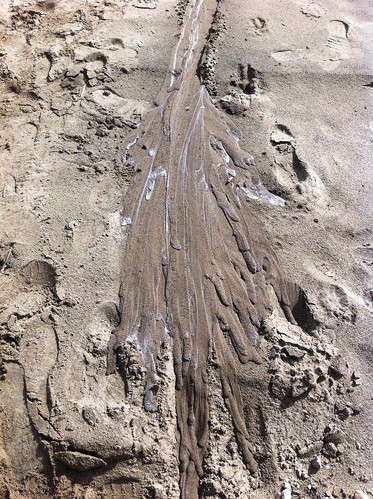
Next I tried to set up a simulation where a river had a large floodplain with a levee on only one side:
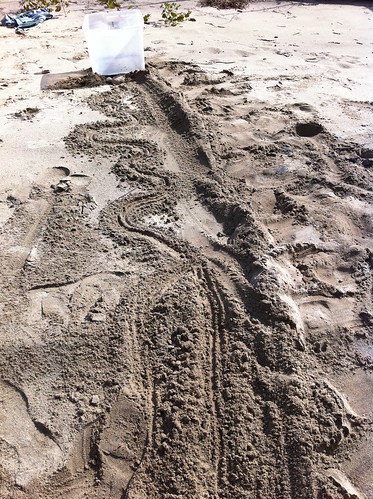
Not only did the water not threaten the levee, it didn't even flow towards it. It ignored my meandering channel and flowed instead to the left.

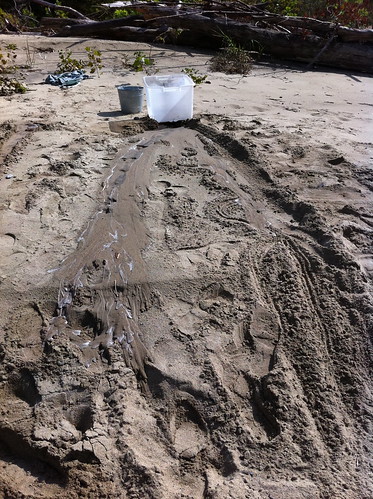
I don't think this is a good illustration of why large floodplains are better, because I think i misjudged the slope. But, you can see that the water did not flow nearly as far or as fast as the channelized flow did.
I even tried testing fate by building homes in the flood plain:
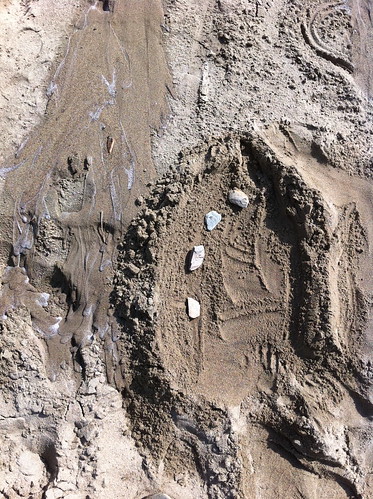
The 'river' had so much space to roam that it didn't erode the levee at all (not pictured).
So what's my point in all of this? There are a lot of people claiming that if more rivers were channelized or dredged, the Irene floods in Vermont wouldn't have been as bad. I find this highly unlikely. It is possible that channelizing and dredging would have MOVED floods - from one home to another. But, it isn't possible to stop floods of that magnitude with this type of channel alteration. If you don't believe me, think about southern California where I grew up. Most of the rivers there are channelized, and some to the point that they are totally ruined. Yet, floods there are still quite commonplace. For instance, if you click here, you can see a map that indicates during an 100 year flood (which Irene probably represented in many parts of Vermont), huge areas of Long Beach and other parts of the LA basin would still flood. Los Angeles has ruined its rivers, but hasn't won flood safety in the exchange. If Olmstead's plan had been adopted instead, the rivers could have been saved, without any increased flood risk, and the only tradeoff would have been a bit less suburban sprawl.
As in many places, towns and homes in Vermont are close to rivers and streams. There are often no easy answers, and some floods will cause devastation regardless of what we do. My point is simply that the more space we can give the rivers, and the more we can avoid tampering with them, the better. We should strive to keep flood plains as intact as possible, and work very hard to make sure levees, bridges, roads, flood walls, and other structures near rivers are well-maintained and don't do more harm than good. In short, we should make our river management decisions based on science and evidence, rather than 'we've done this before and it seemed like it was OK'.
As we rebuild from Irene, we have the choice of doing what we did last time (which obviously did not stop the floods), or trying something new that could work much better.

The second video was pretty disturbing.
ReplyDeleteSo do you see a long-term rebuilding, where Vermont moves structures away from rivers?
I think Vermont is currently redefining their relationships with rivers. Long ago the rivers were important sources of energy for mills, and people just begrudgingly accepted flooding as the price to pay for power (especially while the hills were also being deforested). We've moved away from the rivers as power sources, but we haven't physically moved away from the rivers. (there may BE places for the rivers to be re-imagined as power sources, through micro-hydro, but that's another whole conversation). I don't think it's a good idea to try to move whole villages away from the water, but I do think we need to really look back... the Middlebury River has been channelized more than one time, for instance. It still floods. We don't have a 'control' for how much it would have flooded without channelization, but we know that channelization does not stop floods.
ReplyDeleteMy personal thoughts is we should do the best we can to give the rivers as much space as we can. We do need levees and flood control structures, but let's focus on protecting homes and people, not trying to move the river. If there's a way to protect structures from the edge of the flood plain, rather than mucking around in the river, that is the way to go. It may be that we need to set up a system of farm easements where farmers allow their fields to flood on an occasional basis, and if they lose crops, we pay them back for it. It's cheaper and easier than losing homes and bridges and lives. If too much sediment is accumulating in the riverbed (as some claim), rather than just digging it out again and again and causing erosion, let's look at reducing the amount of sediment getting into the river.
There's a lot of early and mid 20th century engineering being dragged out of the dusty closets right now. What some people are doing to the rivers is essentially equivalent to pulling out the leeches and turpentine to cure a sick patient. We know these old methods aren't best, and we have the ability to do better, as long as we aren't intellectually lazy and afraid to try something different.
And yes, I do think if a structure is totally destroyed, we should look at finding another place to rebuild. It may not always be possible, and it may rely on people being flexible about property boundaries, or helping neighbors acquire new land... but it's going to be necessary in some cases.
nice..
ReplyDeleteI always prefer to read the quality content and this thing I found in you post. Thanks for sharing.
ReplyDeleteBlog